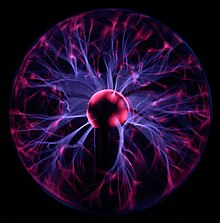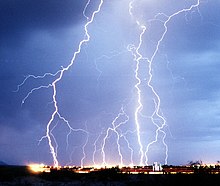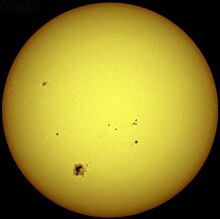Plasma (state of matter)
In physics and chemistry, the fourth state of aggregation of matter, a fluid state similar to the gaseous state but in which a certain proportion of its particles are electrically charged (ionized) and do not have electromagnetic balance, for this reason they are good electrical conductors and their particles respond strongly to long-range electromagnetic interactions. In a somewhat synthetic way, plasma can be characterized as an ionized gas.
Plasma has its own characteristics that do not occur in solids, liquids or gases, which is why it is considered another state of aggregation of matter. Like gas, plasma does not have a definite shape or volume unless it is enclosed in a container. Plasma under the influence of a magnetic field can form structures such as filaments, rays, and double layers. Atoms in this state are free to move; the higher the temperature, the faster the atoms in the gas move, and at the moment of colliding the speed is so high that a detachment of electrons occurs.
Heating a gas can ionize its molecules or atoms (reducing or increasing their number of electrons to form ions), turning it into a plasma. Ionization can also be induced by other means, such as the application of a strong electromagnetic field by a laser or microwave generator, and is accompanied by dissociation of covalent bonds, if present.
Plasma is the most abundant state of aggregation in the Universe, and most visible matter is in the plasma state, most of which is rarefied intergalactic plasma (particularly the center of intraclusters) and in the stars. Plasma is primarily associated with stars.
Early history
Plasma was first identified in the laboratory by Sir William Crookes. Crookes presented a lecture on what he termed "radiant matter"; before the British Association for the Advancement of Science, in Sheffield, on Friday, August 22, 1879. However, systematic studies of plasma began with the investigations of Irving Langmuir and his colleagues in the 1920s. Langmuir also introduced the term "plasma" as a description of ionized gas in 1928:
Except near the electrodes, where there are pods that contain very few electrons, ionized gas contains ions and electrons in an almost equal number, so the resulting spatial load is very small. We will use the plasma name to describe this region that contains balanced loads of ions and electrons.
Lewi Tonks and Harold Mott-Smith, who worked with Langmuir in the 1920s, recall that Langmuir first used the term by analogy with blood plasma. Mott-Smith recalls, in particular, that the transport of electrons from the thermionic filaments reminded Langmuir of "the way blood plasma carries red and white blood cells and germs".
Definitions
The fourth state of matter
Plasma is the fourth state of matter after solid, liquid, and gas. It is a state of matter in which an ionized substance becomes highly electrically conductive to the point that long-range electric and magnetic fields dominate their behavior. Plasma is typically an electrically quasineneutral medium of unbound positive and negative particles, ie the total charge of a plasma is approximately zero. Although these particles are not bound, they are not "free" in the sense of not experiencing forces. Moving charged particles generate electrical currents, and any movement of a charged plasma particle affects and is affected by the fields created by the other charges. In turn, this governs collective behavior with many degrees of variation.
Plasma is distinguished from other states of matter. In particular, describing a low-density plasma as a mere "ionized gas" is wrong and misleading, even though it is similar to the gas phase in that both do not assume a definite shape or volume. The following table summarizes some of the main differences:
| Property | Gas | Plasma |
|---|---|---|
| Interactions | Binaria: The collisions of two particles are the rule, those of three bodies are extremely rare. | Collective: The waves, or organized movement of plasma, are very important because particles can interact large distances through the electrical and magnetic forces. |
| Electrical resistivity and conductivity | Very low: The gases are excellent insulation to electrical field intensity of tens of kilovolts per centimeter. | Very high.: For many purposes, the conductivity of a plasma can be treated as infinite. |
| Species acting independently | One: All gas particles behave similarly, greatly influenced by collisions between them and by gravity. | Two or more: The electrons and ions have different loads and masses, so they behave differently in many circumstances, resulting in various types of specific plasma waves and instability. |
| Speed distribution | Maxwelliano: collisions usually lead to a maxwellian speed distribution of all gas particles. | Often not maxwellian: Collision interactions are relatively weak in hot plasmas and external forces can remove the plasma from local balance. |
Ideal Plasma
Three factors define an ideal plasma:
- Appropriation of plasma: Appropriation of plasma applies when the plasma parameter ..which represents the number of load carriers within the Debye dial is much greater than the unit. It can be easily demonstrated that this criterion is equivalent to the smallness of the ratio of electrostatic and thermal energy densities of plasma. Such plasmas are called weakly coupled.
- Bulk interactions: Debye's length is much lower than the physical size of the plasma. This criterion means that interactions in the bulk of the plasma are more important than those on its edges, where border effects can take place. When this criterion is met, plasma is quasineutral.
- Without collisions: The frequency of electron plasma (which measures the oscillations of electrons in plasma) is much greater than the frequency of electron-neutral collision. When this condition is valid, electrostatic interactions dominate the processes of ordinary kinetic gas. Such plasmas are called without collisions.
Non-neutral plasma
The strength and range of the electrical force and the good conductivity of plasmas often ensure that the densities of positive and negative charges in any sizeable region are equal ("quasineneutrality"). A plasma with a significant excess of charge density or, in the extreme case, composed of only one species, is called a non-neutral plasma. In such a plasma, electric fields play a dominant role. Some examples are beams of charged particles, an electron cloud in a Penning trap, and positron plasmas.
Dusty Plasma
A dusty plasma contains tiny charged dust particles (typically found in space). Dust particles acquire high charges and interact with each other. A plasma that contains larger particles is called a grain plasma. Under laboratory conditions, dusty plasmas are also called complex plasmas.
Examples of plasmas
Some examples of plasmas are:
| Produced artificially | Land plasma | Space and astrophysical plasma: |
|---|---|---|
|
|
|
Applications
Plasma physics can find application in various areas:
- Gas downloads (gassose electronics).
Parameters of a plasma
Since plasmas exist in very different contexts and with diverse characteristics, the first task of plasma physics is to properly define the parameters that decide the behavior of a plasma. The main parameters are the following:
Neutrality and species present
Plasma is made up of equal numbers of positive and negative charges, which cancels out the total charge of the system. In such a case one speaks of a neutral or near-neutral plasma. Non-neutral or unstable plasmas also exist, like the flow of electrons inside a particle accelerator, but they require some kind of external confinement to overcome the electrostatic repulsion forces.
The most common plasmas are those formed by electrons and ions. In general, there can be several species of ions within the plasma, such as positively ionized molecules (cations) and others that have captured an electron and provide a negative charge (anions).
Lengths
The Debye length or electromagnetic shielding. The length of a plasma wave also depends on the concave content of its container, which influences because its parallelism with respect to the x axis on earth affects the length of said spectrum wave electromagnetic.
The plasma frequency
Just as the Debye length provides a measure of the typical lengths in a plasma, the plasma frequency (ω ω p{displaystyle omega _{p}}) describes his characteristic times. Suppose that in a plasma in balance and without load densities a small displacement of all electrons is introduced in one direction. These will feel the attraction of ions in the opposite direction, will move towards it and begin to swing around the original position of balance. The frequency of such oscillation is what is called plasma frequency. The plasma frequency of electrons is:
- ω ω pe=(nee2/meε ε 0)1/2{displaystyle omega _{pe}=(n_{e}e^{2}/m_{e}varepsilon _{0})^{1/2},}
where me{displaystyle m_{e} is the mass of the electron and e{displaystyle e} your burden.
Temperature: thermal velocity
In general, the particles of a certain species located at a given point do not have the same speed: on the contrary, they present a distribution that in thermal equilibrium is described by the Maxwell-Boltzmann distribution. The higher the temperature, the greater the dispersion of speeds (the wider the curve that represents it).
A measure of such dispersion is the root mean square velocity which, at equilibrium, is also called the thermal velocity. It is common, although formally incorrect, to also speak of thermal velocity and temperature in plasmas far from thermodynamic equilibrium.[citation needed] In such a case, the corresponding temperature is mentioned. at a given root mean square speed. The thermal velocity of the electrons is:
- vTe=(kTe/me)1/2{displaystyle v_{Te}=(kT_{e}/m_{e})^{1/2},}
The plasma parameter
The plasma parameter (Interpreter Interpreter {displaystyle Gamma }) indicates the average number of particles contained in a sphere whose radius is the length of Debye (Debye dial). The definition of plasma, according to which the electromagnetic interaction of a particle with the multitude of distant particles dominates the interaction with the next few neighbors, can be written in terms of the plasma parameter as Interpreter Interpreter 1{displaystyle Gamma gg 1}. This is: there are a large number of particles contained in a Debye sphere. It is common to refer to this inequality as a "plasma condition".
Some authors adopt an inverse definition of the plasma parameter (g=1/Interpreter Interpreter {displaystyle g=1/Gamma }), so the plasma condition turns out to be g.. 1{displaystyle gll 1}.
The plasma parameter of the electrons is:
- Interpreter Interpreter =(4π π /3)neλ λ D3{displaystyle Gamma =(4pi /3)n_{e}lambda _{D}^{3}},
Theoretical models
After knowing the values of the parameters described in the previous section, the student of plasmas must choose the most appropriate model for the phenomenon at hand. The differences between different models reside in the detail with which they describe a system, so that a hierarchy can be established in which higher level descriptions are deduced from the lower ones after assuming that some of the variables behave in a prescribed manner. These assumptions or reasonable approximations are not strictly true but allow us to understand phenomena that would be difficult to treat in more detailed models.
Of course, not all species have to be described in the same way: for example, because ions are much heavier than electrons, it is common to analyze the dynamics of the latter taking ions as immobile or study the movements of ions assuming that electrons react much faster and therefore are always in thermodynamic equilibrium.
Since long-range electromagnetic forces are dominant, any plasma model will be coupled to Maxwell's equations, which determine electromagnetic fields from the charges and currents in the system.
The most widely used fundamental models in plasma physics, listed in decreasing order of detail, that is, from microscopic to macroscopic, are discrete models, continuous kinetic models, and fluid or hydrodynamic models.
Discrete models
The maximum detail in the modeling of a plasma is to describe the dynamics of each of its particles according to Newton's second law. To do this with complete accuracy in a system of N{displaystyle N} particles would have to calculate the order N2{displaystyle N^{2}} interactions. In most cases, this exceeds the ability to calculate the best current computers.
However, thanks to the collective character of plasma, reflected in the plasma condition, a simplification is possible that makes the calculation much more manageable. This simplification is the one adopted by the so-called Particle-In-Cell (PIC; Particle-In-Cell) numerical models: the space of the system is divided into a not very large number of small cells. At each instant of evolution, the number of particles and the average speed in each cell are counted, thus obtaining charge and current densities that, inserted into Maxwell's equations, allow the calculation of electromagnetic fields. After that, the force exerted by these fields on each particle is calculated and its position is updated, repeating this process as many times as appropriate.
The PIC models enjoy great popularity in the study of plasmas at high temperatures, in which the thermal velocity is comparable to the rest of the characteristic velocity of the system.
Continuous kinetic models
When the density of plasma particles is large enough, it is convenient to reduce their distribution to an average distribution function. This represents the density of particles contained in an infinitesimal region of phase space, that is, the space whose Coordinates are positions and amounts of motion. The equation that governs the temporal evolution of the distribution functions is the Boltzmann equation. In the particular case in which collisions are negligible, the Boltzmann equation reduces to the Vlasov equation, proved by Anatoly Vlasov.
Kinetic physical models are often used when the particle number density is so large that discrete modeling is unaffordable. On the other hand, kinetic models constitute the basis of analytical studies on hot plasmas.
Fluid or hydrodynamic models
For plasmas at low temperatures, in which we study processes whose characteristic velocities are much greater than the thermal velocity of the plasma, we can simplify the model and assume that all particles of a species at a given point have the same velocity or are close enough to equilibrium to assume that their velocities follow the Maxwell-Boltzmann distribution with a position-dependent mean velocity.[citation needed] We can then derive some equations of fluids for each species which, in their most general form, are called Navier-Stokes equations. Unfortunately, in many cases these equations are excessively complex and unmanageable; then we have to resort to additional simplifications.
Contenido relacionado
Redshift
Wind
Becquerel




















